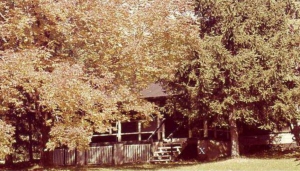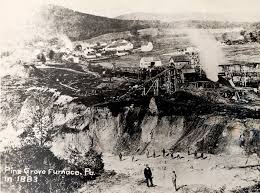The first European colonists operated farming settlements around the Northeast throughout the 18th century. Central Pennsylvania, and specifically Cumberland County, at this time was widely home to German settlers who likely utilized the land that became Bunker Hill Farm in 1785. The farm was functioning before the United States had even elected their first president, who would be George Washington in 1787. Washington’s presidency would mostly be characterized as peaceful, however this peace did not last long as the British soon began restricting US trade and imprisoning American seamen, leading to the War of 1812. During the war, embargoes created an increased need for domestic items such as clothing and ironworks. Businessmen took advantage of this opportunity and began to industrialize. When the War of 1812 ended in 1815, America had begun an industrial revolution, with iron quickly becoming one of the most prevalent industries. In 1861, with many states having already seceded, the Civil War began. This war lasted four years, ravishing most of the Southern and Eastern parts of the United States, including areas close to Camp Michaux like Gettysburg. Iron continued to be an important industry during this war, as there was high demand for the material to manufacture weapons. After the Civil War, the United States began a period of reconstruction in the South. This period of reconstruction called for an excess amount of industrial supplies, which the Pine Grove Iron Furnace, established at Camp Michaux in 1794, would have produced. Pine Grove Iron Furnace continued to function through historical events such as economic depressions and World War I, until its closing in 1924.
Bunker Hill Farm was privately owned from 1785 until 1794, when the iron industry purchased it; the original structure is pictured below.

A photo of the original farm house at Bunker Hill Farm used throughout the various periods of occupation at Camp Michaux. Photo courtesy of the Camp Michaux Walking Tour by David Smith http://www.schaeffersite.com/michaux/WalkingTour.pdf
Some typical farm products that would have been produced here include grains such as wheat, corn, and rye, and animal products like milk, meat, and wool. When the iron industry bought the land with the farm on it in 1794, activity adjusted to serve the furnace. The farm continued producing food at a higher rate, but the most prominent activity at this time was the production of charcoal as fuel for the furnace. The picture below depicts what the furnace activity looked like in 1883.

A photo of the Pine Grove Iron Furnace operating in 1883 showing the extensive quarrying and deforestation of the surrounding area. Photo courtesy of the Pennsylvania Department of Conservation and Natural Resources via http://www.docs.dcnr.pa.gov/stateparks/findapark/pinegrovefurnace/index.htm.
To make charcoal, extensive deforestation and burning took place at Camp Michaux. Many workers were needed to carry out the production of charcoal, and of course to run the furnace itself to produce the iron. The furnace experienced a period of increased productivity from 1861 to 1877, during the Civil War and Reconstruction, but faced financial difficulties after these periods when demand suddenly decreased. The furnace held on and was functional until its closing in 1924.
There is still more to learn at Camp Michaux, and as we continue our archaeological work, we intend to try and find clues that can help us answer a few key research questions about the farm and iron furnace period. As we know, the introduction of Pine Grove Iron Furnace into the area would have dramatically changed the lives of those living and working at Bunker Hill Farm. We lack information, however, in exactly what changes occurred and what their degree of impact was in the area. The main questions we are currently focusing on for this time period include:
- What physical remains can be found at Camp Michaux today that indicate the increase in amount of commodities Bunker Hill Farm had to produce after the introduction of Pine Grove Iron Furnace?
- Since Pine Grove Iron Furnace required charcoal to operate, what were the impacts of extreme deforestation on the surrounding land? To what extent did the methods used for deforestation by the original farm and later by the iron furnace differ?
- With the changes in the land, were there also changes in the layout of the farm? Were crop fields moved to different locations as deforestation and pollution increased? Were new crops or animals more commonly grown and raised to accommodate the increased activity at the iron furnace as well as its environmental impacts?
Physical remains such as iron products, animal bones, and potentially even foundational remains of old structures that we may find at Camp Michaux could help us answer the questions about the productivity of the farm and the layout changes that may have occurred. Using Geographic Information System (GIS) mapping to detect changes in vegetation in the area and studying the components of the soil today can help us answer questions about how the deforestation progressed and the lasting effects of it on the land.
If you would like to learn more about the time period during which Bunker Hill Farm and Pine Grove Iron Furnace existed, here are some easily accessible books you may find at your local library that are also available for purchase on Amazon and some fun websites to check out!
Books:
McMurry, Sally
2017 Pennsylvania Farming: A History in Landscapes. University of Pittsburgh Press, Pittsburgh, Pennsylvania.
Flower, Lenore Embrick.
1975 History of Pine Grove Furnace. The Cumberland County Historical Society, Carlisle, Pennsylvania.
Websites:
History
War of 1812. Webpage, https://www.history.com/topics/war-of-1812, accessed March 2, 2018.
Pennsylvania Department of Conservation and Natural Resources
History of Pine Grove Furnace State Park. Webpage, http://www.dcnr.pa.gov/StateParks/FindAPark/PineGroveFurnaceStatePark/Pages/History.aspx, accessed March 5, 2018.
Library of Congress Teachers with Primary Sources
The Industrial Revolution in the United States. Electronic document, http://www.loc.gov/teachers/classroommaterials/primarysourcesets/industrial-revolution/pdf/teacher_guide.pdf, accessed March 3, 2018.
Created by: Kalei Downing, Beth Eidam, and Marisa Schaefer
Andre Weltman, chair, Friends of PGF says:
Sorry but there are a large number of inaccurate statements in this blog post. It’s so wrong that it’s not worth trying to correct point by point. I’ll offer one basic correction: Pine Grove Furnace in Cumberland County PA stopped making iron in 1895, not 1924. Please see various items on the bottom half of http://www.FriendsofPineGrove.org/documents for better information.
June 27, 2024 — 8:53 pm
brunom says:
Hi, Andre, as you know this was a student project completed several years ago now. I appreciate you pointing out the inconsistencies that were missed. They actually do cite several of the sources you mention but the final product is not always perfect. Thank you for providing another resource to refer to.
August 14, 2024 — 9:06 pm